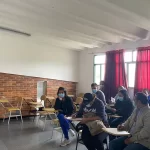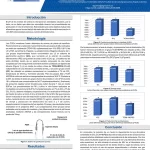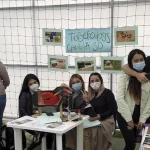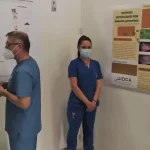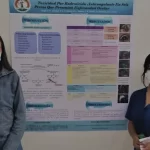Semillero
Biología Molecular e Inmunología Veterinaria
Biología Molecular e Inmunología Veterinaria
Grupo: CIENCIA ANIMAL
Consolidar un semillero que estimule la actividad investigativa y de escritura de artículos de revisión en la línea de salud animal entre los estudiantes de las carreras involucradas, a fin de que cada miembro pueda desarrollar trabajos de interés y utilidad que sirvan como opción de graduación y publicación.
Misión
El semillero de investigación en Biología Molecular e Inmunología Veterinaria está conformado por un grupo de docentes y estudiantes de la Facultad de Ciencias Agropecuarias que promueven la generación de ideas, ejecución de proyectos de investigación y escritura y escritura de artículos de actualidad en la línea de Salud Animal.
El semillero busca fomentar, desarrollar y contribuir con la formación en investigación científica, a través de actividades orientadas al fortalecimiento del espíritu investigativo del estudiante, que respondan a las necesidades del medio y generen soluciones a problemas que afectan el panorama nacional e internacional.
Visión
El semillero de Ciencias Pecuarias se consolidará como un semillero de investigadores en la línea de salud animal institucional mediante la divulgación de sus productos en congresos, seminarios, eventos académicos y revistas indexadas.
Objetivos específicos:
- Promover en los estudiantes la capacidad de investigación y de gestión de procesos, como base para su quehacer profesional y como inicio para sus estudios de posgrados.
- Estructurar un semillero de Investigación reconocido en la Institución.
- Generar y participar en eventos de divulgación y socialización de la información.
Líneas de Investigación
-
-
- Salud Animal
-

COORDINADORES
PRODUCTOS DESTACADOS
Evaluating the immunogenicity of chemically-synthesised peptides derived from foot-and-mouth disease VP1, VP2 and VP3 proteins as vaccine candidates
Foot-and-mouth disease (FMD) is one of the most contagious veterinary viral diseases known, having economic, social and potentially devastating environmental impacts. The vaccines currently being marketed/sold around the world for disease control and prevention in bovines do not stimulate the production of antibodies having crossed reactions to different serotypes. This means that if an animal becomes infected by a serotype which has not been included in a vaccine then it will develop the disease. Synthetic peptide vaccines represent a safer option and (depending on the design) can stimulate antibodies protecting against different variants. Based on the forgoing, this work was aimed at evaluating FMDV VP1, VP2 and VP3 protein-derived, modified and chemically-synthesised peptides’ ability to induce an immune response for developing a vaccine contributing towards controlling the disease. VP1, VP2 and VP3 proteins’ conserved regions were selected for this. Peptides from these regions were chemically synthesised; binding assays were then carried out for ascertaining whether they were involved in BHK-21 cell binding. Selected peptides’ structure and location were studied. Peptides which did bind were modified and formulated with Montanide ISA 70 adjuvant; 17 animals were immunised twice with the formulation. The animals were genotyped by amplifying the BoLA-DRB3.2 gene. Blood samples were taken from 17 cattle on day 43 post-first immunisation for studying the formulation’s immunogenicity. The sera were used in ELISA, immunofluorescence, flow cytometry, immunoadsorption and seroneutralisation assays. The A24 Cruzeiro and O1 Campos virus serotypes were used for these assays. The results revealed that even though protein exposure and 3D structure might be different amongst serotypes, the antibodies so produced could inhibit virus entry to cells, thereby showing the selected peptides’ in vitroprotection-inducing ability.
Evaluating the immunogenicity of chemically-synthesised peptides derived from foot-and-mouth disease VP1, VP2 and VP3 proteins as vaccine candidates
Foot-and-mouth disease (FMD) is one of the most contagious veterinary viral diseases known, having
economic, social and potentially devastating environmental impacts. The vaccines currently being marketed/
sold around the world for disease control and prevention in bovines do not stimulate the production
of antibodies having crossed reactions to different serotypes. This means that if an animal becomes
infected by a serotype which has not been included in a vaccine then it will develop the disease. Synthetic
peptide vaccines represent a safer option and (depending on the design) can stimulate antibodies protecting
against different variants. Based on the forgoing, this work was aimed at evaluating FMDV VP1,
VP2 and VP3 protein-derived, modified and chemically-synthesised peptides’ ability to induce an
immune response for developing a vaccine contributing towards controlling the disease. VP1, VP2 and
VP3 proteins’ conserved regions were selected for this. Peptides from these regions were chemically synthesised;
binding assays were then carried out for ascertaining whether they were involved in BHK-21
cell binding. Selected peptides’ structure and location were studied. Peptides which did bind were modified
and formulated with Montanide ISA 70 adjuvant; 17 animals were immunised twice with the formulation.
The animals were genotyped by amplifying the BoLA-DRB3.2 gene. Blood samples were
taken from 17 cattle on day 43 post-first immunisation for studying the formulation’s immunogenicity.
The sera were used in ELISA, immunofluorescence, flow cytometry, immunoadsorption and seroneutralisation
assays. The A24 Cruzeiro and O1 Campos virus serotypes were used for these assays. The results
revealed that even though protein exposure and 3D structure might be different amongst serotypes, the
antibodies so produced could inhibit virus entry to cells, thereby showing the selected peptides’ in vitro
protection-inducing ability.
Transcriptome profiling of gene expression during immunisation trial against Fasciola hepatica: identification of genes and pathways involved in conferring immunoprotection in a murine model
Fasciolosis remains a significant food-borne trematode disease causing high morbidity around the
world and affecting grazing animals and humans. A deeper understanding concerning the molecular mechanisms
by which Fasciola hepatica infection occurs, as well as the molecular basis involved in acquiring protection is
extremely important when designing and selecting new vaccine candidates. The present study provides a first
report of microarray-based technology for describing changes in the splenic gene expression profile for mice
immunised with a highly effective, protection-inducing, multi-epitope, subunit-based, chemically-synthesised
vaccine candidate against F. hepatica.


